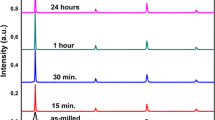Abstract
The experimental studies of Fe68Ni32 and Fe23Ni77 alloys by transmission electron microscopy and X-ray electron spectroscopy show that the ordering-separation phase transition in these alloys occurs in a temperature range near 600°C. At temperatures higher than the transition temperature, the ordering energy of the alloy is positive, and the structures contain clusters enriched in one of the components. After heat treatment at the temperatures where the invar effect in the Fe68Ni32 alloy is maximal, a modulated microstructure forms. Below the transition temperature, the ordering energy is negative, which provides a tendency to formation of chemical compounds. After aging at these temperatures (where the Fe23Ni77 alloy exhibits high permalloy properties), highly dispersed completely coherent particles of the FeNi3 phase with structure L12 precipitate in a solid solution.
Similar content being viewed by others
References
E. P. Wohlfarth, “Invar behavior in crystalline and amorphous alloys,” J. Magn. Magn. Mater. 10, 120–125 (1979).
M. Shimitsu, “Magnetic volume effect in itenerat electron ferromagnets,” J. Magn. Magn. Mater. 20, 47–55 (1980).
E. F. Wasserman, “Invar moment-volume instabilities in transition metals and alloys,” J. Magn. Magn. Mater. 100, 346–362 (1991).
K. J. Ducki, “Structure and precipitation strengthening in a high tempering Fe–Ni alloy,” J. Mater. Manuf. Eng. 21, 25–28 (2007).
O. A. Khomenko, “Origin and specific features of invar anomalies of physical properties: Fe–Ni alloys with an fcc lattice,” Phys. Met. Metallogr.104(2), 146–156 (2007).
O. Kubashewski, Iron–Binary Alloy Systems (Springer, Berlin, 1982).
Y. Ustinovshchikov, “‘Chemical’ phase transition in alloys: ordering–phase separation,” COSSMS 14, 7–20 (2010).
L. Fang, F. Xiao, Y. Wang, Z. Tao, K. MuKai, “Density and molar volume of liquid Ni–Co binary alloys,” Mater. Sci. Eng. B 132, 174–178 (2006).
E. Ichise, K. Shaw, and S. Taniguchi, “Thermodynamic study on liquid binary alloys of Co, Cr, and Ni,” J. Mass. Spectrum. Soc. Jap. 41, 343–350 (1993).
G. I. Sil’man, “Compiled Fe–Ni phase diagram with author’s correction,” Metalloved. Term. Obrab. Met., No. 3, (3–10) (2012).
A. Shibata, S. Morito, T. Furuhara, and T. Maki, “Local orientation change inside lenticular martensite plate in Fe–33Ni alloy,” Scripta Materialia 53, 597–602 (2005).
T. Heumann and G. Karsten, Arch. Eisenhüttenwes. B 34, 781–785 (1963).
Yu. I. Ustinovshchikov, “Phase transformations in an Ni–7.5 wt % Al alloy,” Russian Metallurgy (Metally), No. 9, 786–790 (2012).
Author information
Authors and Affiliations
Corresponding author
Additional information
Original Russian Text © Yu.I. Ustinovshchikov, I.N. Shabanova, N.V. Lomova, 2015, published in Metally, 2015, No. 3, pp. 60–66.
Rights and permissions
About this article
Cite this article
Ustinovshchikov, Y.I., Shabanova, I.N. & Lomova, N.V. Microstructures responsible for the invar and permalloy effects in Fe-Ni alloys. Russ. Metall. 2015, 389–394 (2015). https://doi.org/10.1134/S0036029515050158
Received:
Published:
Issue Date:
DOI: https://doi.org/10.1134/S0036029515050158



